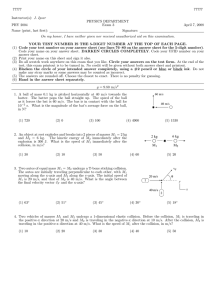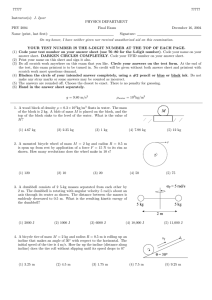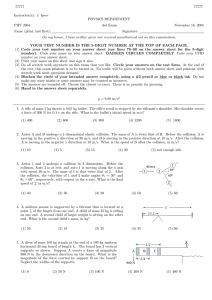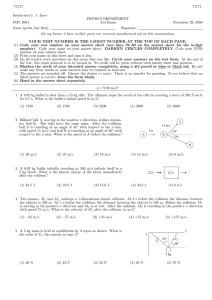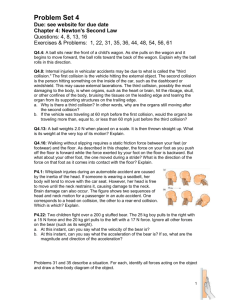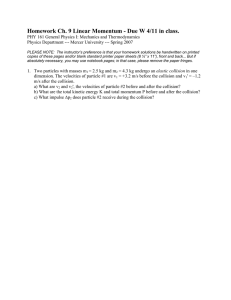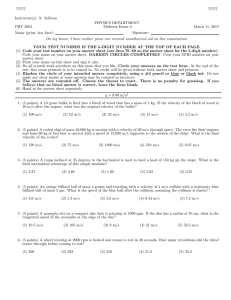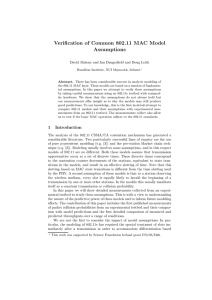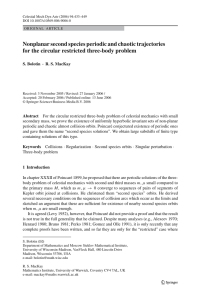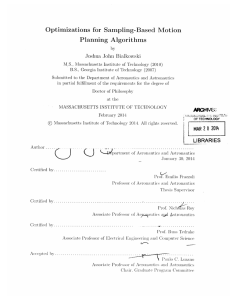77777 J. Ipser PHYSICS DEPARTMENT PHY 2004
advertisement
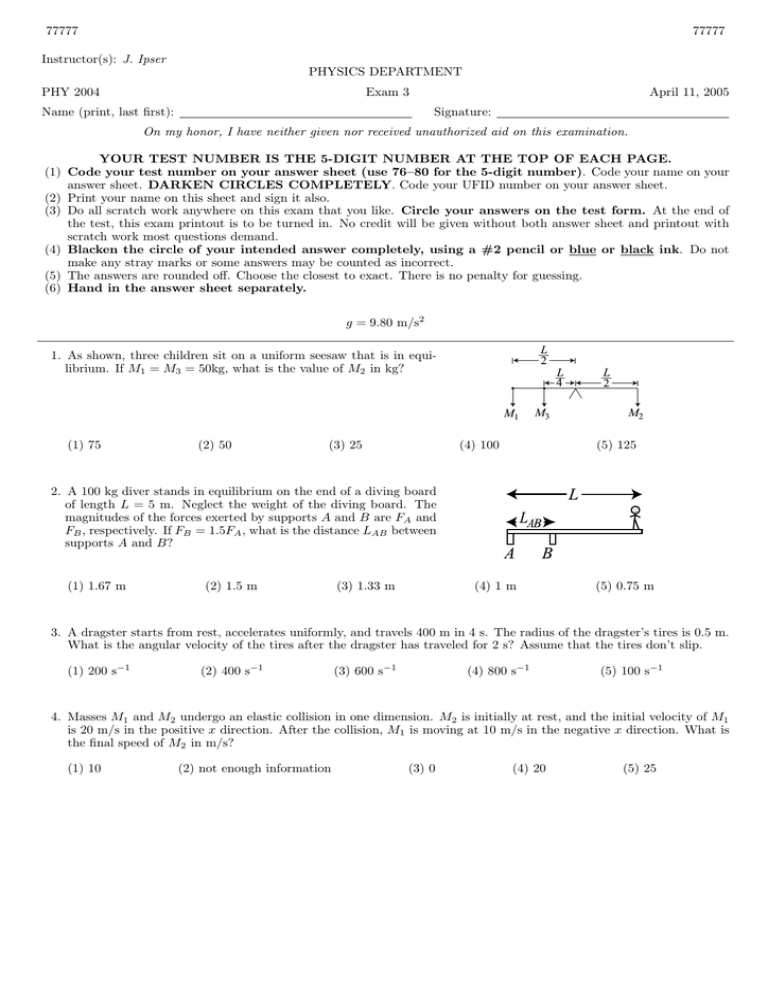
77777 77777 Instructor(s): J. Ipser PHYSICS DEPARTMENT PHY 2004 Exam 3 Name (print, last first): April 11, 2005 Signature: On my honor, I have neither given nor received unauthorized aid on this examination. YOUR TEST NUMBER IS THE 5-DIGIT NUMBER AT THE TOP OF EACH PAGE. (1) Code your test number on your answer sheet (use 76–80 for the 5-digit number). Code your name on your answer sheet. DARKEN CIRCLES COMPLETELY. Code your UFID number on your answer sheet. (2) Print your name on this sheet and sign it also. (3) Do all scratch work anywhere on this exam that you like. Circle your answers on the test form. At the end of the test, this exam printout is to be turned in. No credit will be given without both answer sheet and printout with scratch work most questions demand. (4) Blacken the circle of your intended answer completely, using a #2 pencil or blue or black ink. Do not make any stray marks or some answers may be counted as incorrect. (5) The answers are rounded off. Choose the closest to exact. There is no penalty for guessing. (6) Hand in the answer sheet separately. g = 9.80 m/s2 L 1. As shown, three children sit on a uniform seesaw that is in equilibrium. If M1 = M3 = 50kg, what is the value of M2 in kg? 2 L L 4 M3 M1 (1) 75 (2) 50 (3) 25 (2) 1.5 m M2 (4) 100 2. A 100 kg diver stands in equilibrium on the end of a diving board of length L = 5 m. Neglect the weight of the diving board. The magnitudes of the forces exerted by supports A and B are FA and FB , respectively. If FB = 1.5FA , what is the distance LAB between supports A and B? (1) 1.67 m 2 (3) 1.33 m (5) 125 L LAB A B (4) 1 m (5) 0.75 m 3. A dragster starts from rest, accelerates uniformly, and travels 400 m in 4 s. The radius of the dragster’s tires is 0.5 m. What is the angular velocity of the tires after the dragster has traveled for 2 s? Assume that the tires don’t slip. (1) 200 s−1 (2) 400 s−1 (3) 600 s−1 (4) 800 s−1 (5) 100 s−1 4. Masses M1 and M2 undergo an elastic collision in one dimension. M2 is initially at rest, and the initial velocity of M1 is 20 m/s in the positive x direction. After the collision, M1 is moving at 10 m/s in the negative x direction. What is the final speed of M2 in m/s? (1) 10 (2) not enough information (3) 0 (4) 20 (5) 25 77777 77777 5. Masses M1 = 0.1 kg and M2 = 0.2 kg undergo a collision in 2 dimensions. Before the collision, M2 is at rest and M1 is moving in the positive x direction. After the collision, M2 is moving with speed 20 m/s at an angle of 30◦ with respect to the x axis, and M1 is also moving at an angle of 30◦ with repsect to the x axis. What is the initial speed v1I of M1 in m/s? (1) 69 (2) 43 (3) 56 y v2I = 0 x 1 2 o 30 2 (4) 92 20 m/s (5) 105 6. Masses M1 and M2 undergo a head-on sticking collision. Before the collision, M1 is moving in the +x direction with speed 20 m/s, and M2 is moving in the −x direction with the same speed. If M1 = 2M2 , what is the speed of the masses, in m/s, after the collision? (1) 6.67 (2) 5.33 (3) 7.5 (4) 4.0 (5) 30 7. A satellite is in an orbit of radius R = 2 × 107 m around the Earth. The speed of the satellite is V . The satellite is then moved to a new orbit in which its speed is V /2. What is the radius of the new orbit? (1) 8 × 107 m (2) 5 × 106 m (3) 107 (4) 3 × 107 m (5) 4 × 108 m 8. An auto of mass 2 × 103 kg travels around a racetrack that is a circle of radius 300 m. The coefficient of static friction is µs = 0.85. What is the smallest amount of time required for the auto to make one complete revolution without slipping? (1) 38 s (2) 48 s (3) 58 s (4) 10 s (5) 69 s

